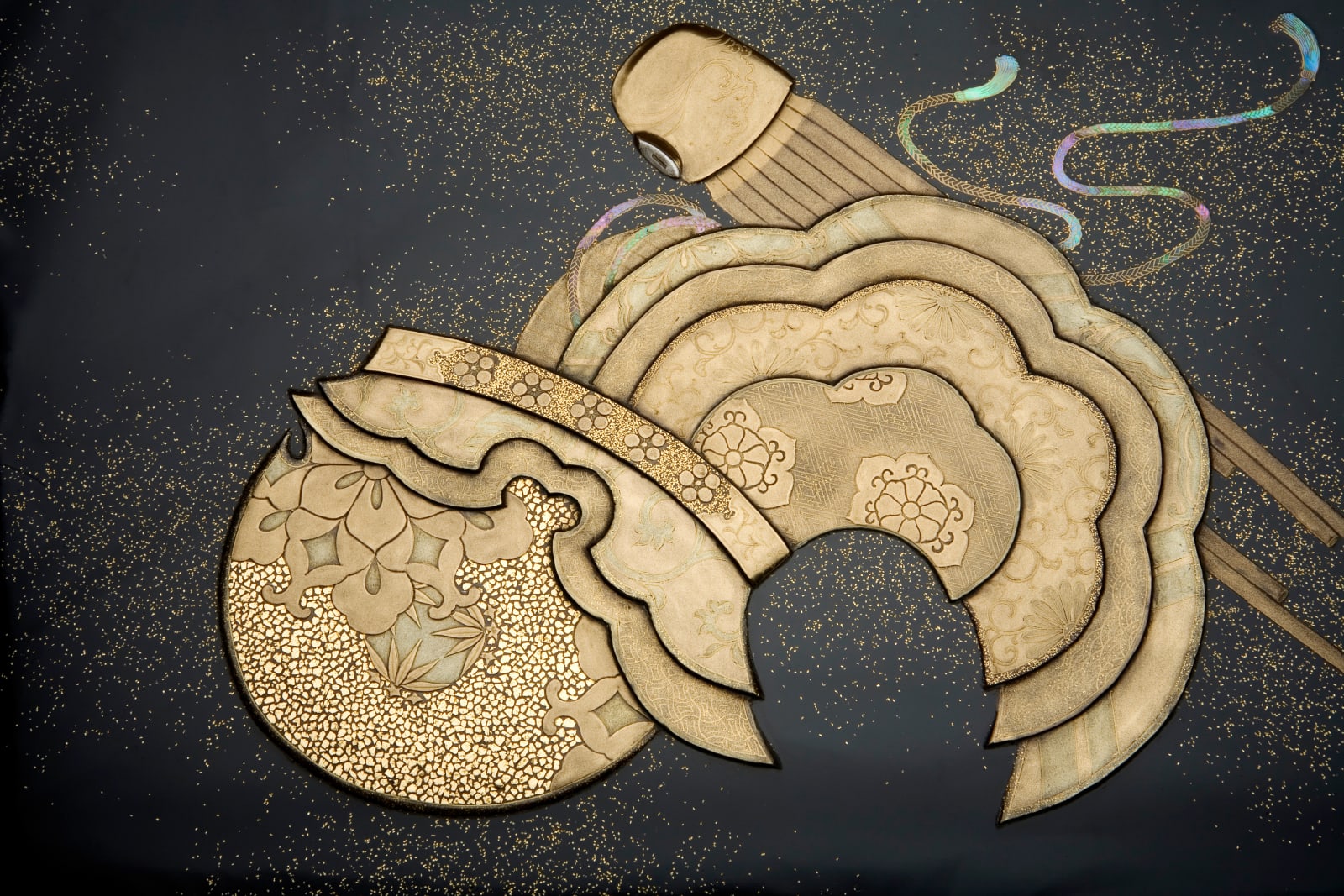Hirobuta Tray with Accouterments of the Bugaku Dance, 1910s
Maki-e lacquer and inlaid shell, silver rim
Size 3 x 24¾ x 16¾ in. (7.7 x 62.8 x 42.5 cm)
T-3188
Further images
A hirobuta (tray with vertical sides), rectangular with slightly bowed sides, the wood substrate finished in highly polished mirror-black roiro lacquer and decorated in gold and aokin hiramaki-e and raised...
A hirobuta (tray with vertical sides), rectangular with slightly bowed sides, the wood substrate finished in highly polished mirror-black roiro lacquer and decorated in gold and aokin hiramaki-e and raised takamaki-e, with inlays of shell as well as gold and silver okibirame flakes with accouterments of the bugaku dance: shō (mouth organ), torikabuto (cap), and kagura-suzu (set of hand bells); finished with a solid silver rim.
Over a lustrous polished black-lacquer ground, the artist who decorated this tray sprinkled different mixtures of gold and silver powder to create a meticulous, semi-abstract design featuring headgear and musical instruments used in bugaku (nowadays generally referred to as gagaku), a performance art of Chinese origin that was adopted by the Japanese imperial court and is today the world’s oldest surviving court dance and music tradition. The largest element is the torikabuto (literally, “bird helmet”), one of several types of headgear worn by bugaku dancers. Beneath it, partially concealed, is a shō, a vertical mouth organ or panpipes with 17 bamboo pipes (two of them silent) set in a cup-shaped wind chest (seen here at the top) with a single metal mouthpiece. The protracted notes of the shō contribute to the archaic-sounding, timeless character of bugaku music, but slightly faster-tempo pieces are sometimes accompanied by the contrasting notes of the kagura-suzu, a set of 12 bells (one here partially hidden) arranged in three tiers and suspended by brass wires from a central handle.
Rectangular trays like this one, with relatively high sides, are known in Japanese as hirobuta and were used to present formal gifts of clothes and precious items; the outstanding technical quality, the choice of an imperial theme for the decoration, and the fact that it is unsigned together suggest that this example was likely intended for use by a member of the imperial family or as an imperial gift.
Over a lustrous polished black-lacquer ground, the artist who decorated this tray sprinkled different mixtures of gold and silver powder to create a meticulous, semi-abstract design featuring headgear and musical instruments used in bugaku (nowadays generally referred to as gagaku), a performance art of Chinese origin that was adopted by the Japanese imperial court and is today the world’s oldest surviving court dance and music tradition. The largest element is the torikabuto (literally, “bird helmet”), one of several types of headgear worn by bugaku dancers. Beneath it, partially concealed, is a shō, a vertical mouth organ or panpipes with 17 bamboo pipes (two of them silent) set in a cup-shaped wind chest (seen here at the top) with a single metal mouthpiece. The protracted notes of the shō contribute to the archaic-sounding, timeless character of bugaku music, but slightly faster-tempo pieces are sometimes accompanied by the contrasting notes of the kagura-suzu, a set of 12 bells (one here partially hidden) arranged in three tiers and suspended by brass wires from a central handle.
Rectangular trays like this one, with relatively high sides, are known in Japanese as hirobuta and were used to present formal gifts of clothes and precious items; the outstanding technical quality, the choice of an imperial theme for the decoration, and the fact that it is unsigned together suggest that this example was likely intended for use by a member of the imperial family or as an imperial gift.







